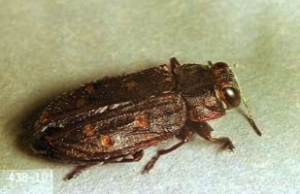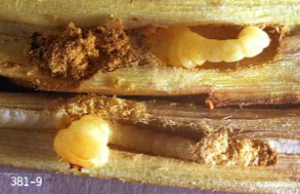Over the past few weeks, we have received several reports of flatheaded borer infestation in blueberry orchards. The flatheaded borers are a complex of over 600 species of beetles in the United States. The adult flatheaded borers (Fig. 1) are metallic wood boring beetles which are perhaps the most serious pests attacking a wide range of bush and tree species. The adult flatheaded borers are beautifully marked, metallic-colored beetles, approximately 1/2 inch long, have short antennae, large conspicuous eyes, and a noticeable tooth on the forelegs. The adult is blunt at the head and tapers to a rounded point at the back end. An adult female lays about 100 eggs, singly, that hatch in 15-20 days. Eggs are firmly attached under bark scales or in bark crevices on the main stem or larger branches. The eggs are pale yellow, wrinkled, flat, and about 1/20 inch in diameter.
The larvae (Fig. 2) are legless and when full-grown can be approximately 1 1/4 inch long. They are usually light colored (whitish-yellow) but may appear to be golden or a paler. Larvae are legless, with prominent flat enlargement just behind the head. These segments are actually part of the insect’s thorax, but appear to be a large flat head, thus the common name. They are commonly found curved like a horseshoe, sluggish and inactive except in very warm weather. The fully developed larvae bore radially deeper into the sapwood or heartwood, and excavate pupal chamber where it overwinters. They pupate for 1-2 weeks the following spring and emerge, when conditions permit, to start the cycle again.
The flatheaded borers are occasional pests of blueberries. The most significant damage results from the larval stage of the flatheaded borers as they bore into the canes. They create galleries which may eventually completely girdle the canes. This type of feeding severs water- and nutrient-conducting vascular tissues which weakens the cane, resulting in stunted growth or death of the cane. Adult beetles are attracted to stressed or damaged blueberry canes, particularly areas with pruning scars or sunburn. Adult female beetles lay eggs on the injured area, and larvae excavate tunnels just beneath the bark and bore through the cane. Excavations are usually filled with tightly packed, finely powdered sawdust. Later, these areas may crack and expose the mines.
The best defense against flatheaded borers is to keep the blueberry bushes healthy and vigorous. Prevention of mechanical damage, wounds, sunscald, or drought stress can significantly reduce the flatheaded borer infestations. Once detected, flatheaded borers can be managed by pruning the bushes. Make sure to: 1) remove old canes that exhibit borer damage and train new canes to take their place; 2) prune at a time of year and in a manner that prevents sunburn of canes to reduce borer damage; and 3) after pruning, chip or remove prunings from the field before immature stages of the borer can complete their development. If high levels of infestation are observed during pruning, make a soil application of an imidacloprid-containing insecticide, such as Admire® 2F or Admire Pro® 4.6F.
Figure 1. Adult Flatheaded borer (Image by: Ken Gray – OSU)
Figure 2. Flatheaded borer larva (Image by: Ken Gray – OSU)

